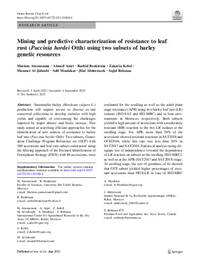Mining and predictive characterization of resistance to leaf rust (Puccinia hordei Otth) using two subsets of barley genetic resources

Authors:
Sustainable barley production will require access to diverse ex-situ conserved collections to develop varieties with high yields and capable of overcoming the challenges imposed by major abiotic and biotic stresses. This study aimed at searching efficient approaches for the identification of new sources of resistance to barley leaf rust (LR). Two subsets, Generation Challenge Program Reference set (GCP) with 190 accessions and leaf rust subset constructed using the filtering approach of the Focused Identification of Germplasm Strategy (FIGS) with 100 accessions, were evaluated for the seedling as well as the adult plant stage resistance (APR) using two LR isolates (ISO-SAT and ISO-MRC) and in four environments in Morocco, respectively. Both subsets yielded a high percent of accessions with a moderately resistant (MR) reaction to the two LR isolates at the seedling stage. For APR, more than 50% of the accessions showed resistant reactions in SAT2018 and GCH2018, while this rate was less than 20% in SAT2017 and SAT2019. Statistical analysis using chi-square test of independence revealed the dependency of LR reaction on subsets at the seedling (ISO-MRC), as well as at the APR (SAT2017 and SAT2018) stage. Furthermore, the test of goodness of fit showed that FIGS_LR yielded higher percentages of resistant accessions than GCP subset in case of ISO-MRC at the seedling stage, and in case of SAT2017 and SAT2018 at APR stage. Although some of the tested machine learning models had moderate to high accuracies, none of them was able to find a strong and significant relationship between the reaction to LR and the environmental conditions showing the needs for more fine tuning of approaches for efficient mining of genetic resources using machine learning.
